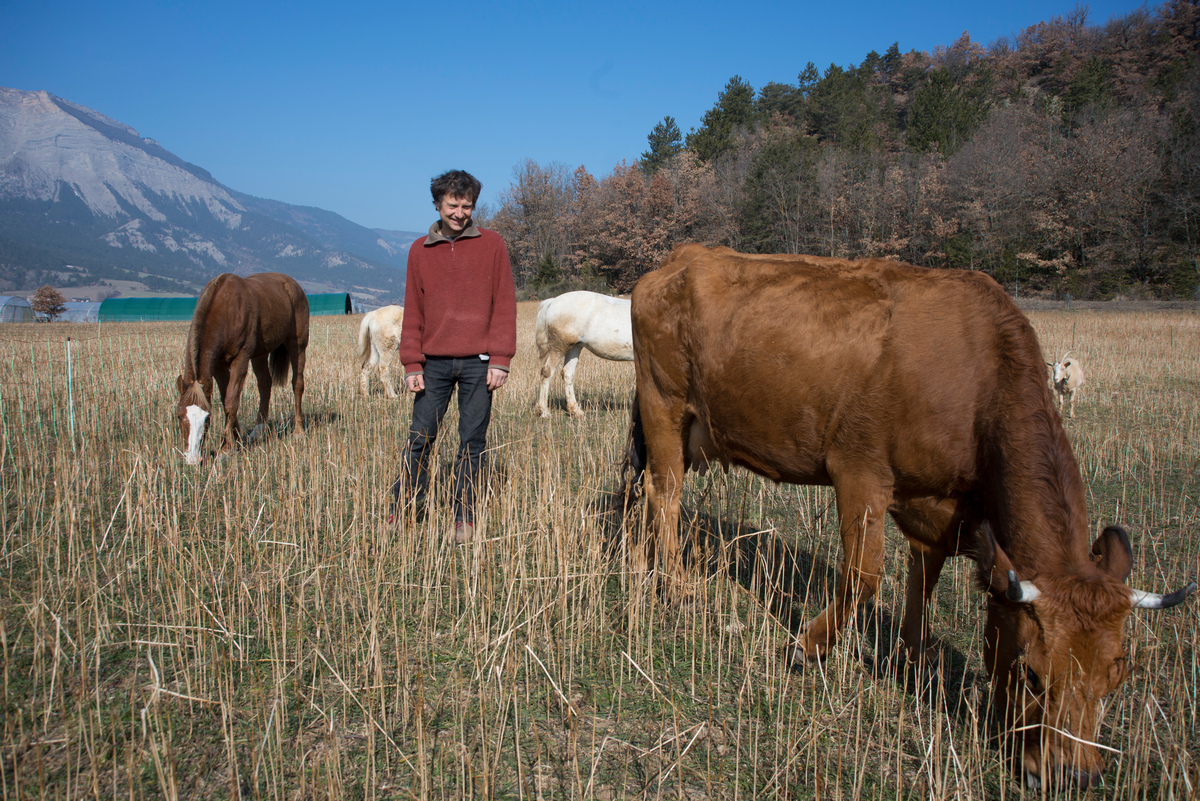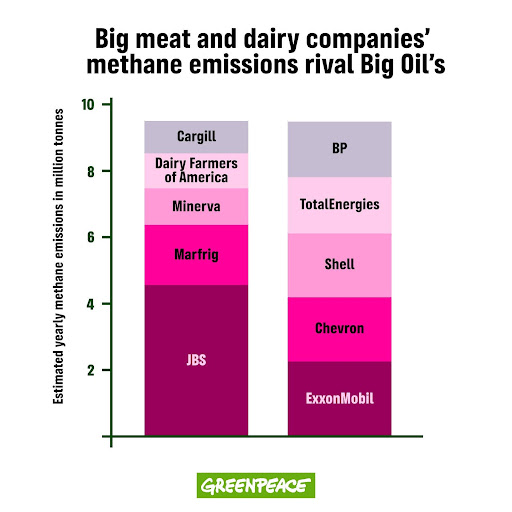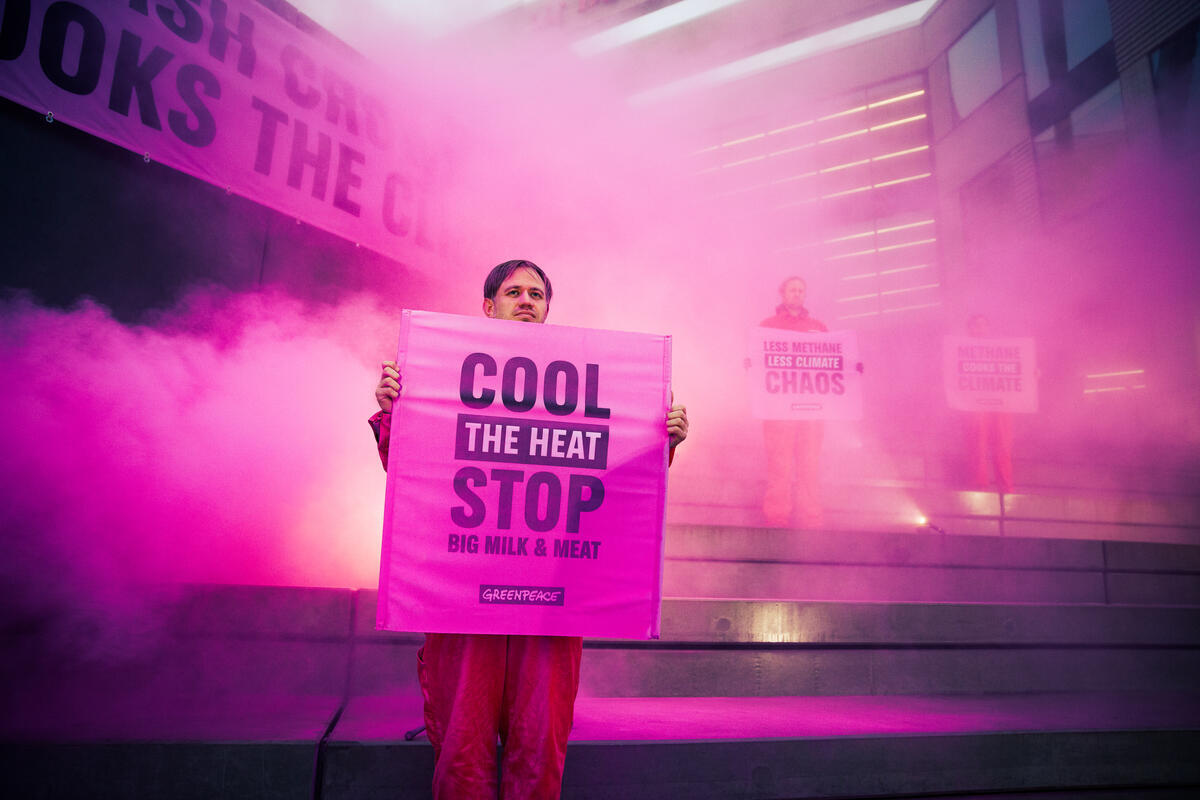As extreme weather events become more frequent and intense all around the world, we wish we could stop the clock – or even slow down time – on climate change. The good news is that we don’t need a time machine to do that.
Right now, the 2024 United Nations Climate Change Conference – commonly known as COP29 – is taking place in Baku, Azerbaijan, and on 19 November discussions focus on food, agriculture and water. Policy makers meeting at these climate negotiations must acknowledge that food systems are responsible for up to 37% of human-made emissions. And if we start taking meaningful actions and transform these systems, they can offer radical cuts in greenhouse gas emissions while restoring nature.
 Jean-Marie Verdet, biodynamic farmer, on his land where cattle coexist. © Emile Loreaux / Greenpeace
Jean-Marie Verdet, biodynamic farmer, on his land where cattle coexist. © Emile Loreaux / GreenpeaceTick, tock… it’s livestock methane o’clock
Our window of limiting planetary heating to 1.5C is closing fast. Cutting methane, a powerful greenhouse gas 80 times stronger than carbon dioxide (CO2 ) over a 20 year period, is key to opening that window and giving us a chance to save millions of lives and livelihoods from the worst impacts of climate change.
Unfortunately, methane emissions are rising faster than ever today, causing the planet to heat up faster. Animal agriculture is the single largest human-made source of methane emissions. And while COP 29 addresses methane, governments have yet to talk about taking meaningful steps to reduce livestock methane.
Greenpeace Nordic’s new study shows that we could rapidly take methane out of the atmosphere. In fact, we could achieve a cooling effectof 0.12°C from business-as-usual temperature rise if high and middle income countries cut meat and dairy production in line with a planetary health diet. This would amount to a 37% reduction of the anticipated mid-century heating of 0.32°C from meat and dairy alone, under projected business-as-usual production and consumption.
Scientists estimate that we are currently on course for a world that has heated up to anywhere between 2.6°C and a 3.1°C by the end of the century. So every decimal of a degree Celsius we reduce now, and as quickly as possible, allows us a fighting chance to limit warming to levels humanity can sustain: which is around 1.5°C as average global temperatures. To put this in context, as many as 410 million people globally could be spared impacts of extreme heat by the turn of the century by preventing a 0.3C rise in global temperatures.
 Future warming projected with meat & dairy reductions in all countries © Greenpeace
Future warming projected with meat & dairy reductions in all countries © GreenpeaceCountdown to COP30
Governments must make a “quantum leap” (according to the Emissions Gap report) in their climate commitments called NDCs, or Nationally Determined Contributions by COP30 in Brazil next year. Countries are required to set new and more ambitious emissions reduction targets to be achieved by 2035 as part of this effort. Reducing agricultural emissions overall and in particular methane from meat and dairy production could be key to that goal.
To do this, we need to move away from the destructive industrial model of meat and dairy production that cooks the planet and only benefits big meat and dairy companies. Five meat and dairy companies emit as much methane as some of the biggest oil companies, yet governments are doing very little, if anything, to reign in their emissions.
 Big meat & dairy companies’ methane emissions rival big oil’s © Greenpeace
Big meat & dairy companies’ methane emissions rival big oil’s © GreenpeaceIn the last round of NDCs in 2020/2021, only 12 countries included greenhouse gas targets for livestock. With the exception of New Zealand, the rest of the countries are not major emitters of livestock emissions. At last year’s COP 28, close to 160 countries committed to include food system emissions in their NDCs.
What do ambitious cuts look like and how can they be achieved? We need concrete and ambitious targets on reducing methane and nitrous oxide from agriculture by 2035 through enacting a time-bound bottom-up shift from industrial agriculture to agroecology. Governments must commit to supporting a just transition fund for farmers – ensuring that the benefits of such change are shared widely, supporting those who stand to lose economically; and put in place regulations that penalise Big Meat and Dairy companies for their emissions, and that help countries shift to ecological and more plant based agriculture this decade.
 Greenpeace Nordic activists protest methane emissions at meat company’s headquarters using pink smoke to convey methane’s impact. Danish Crown is responsible for 83% of the methane emission from Denmarks’ livestock production. © Michael Hedelain / Greenpeace
Greenpeace Nordic activists protest methane emissions at meat company’s headquarters using pink smoke to convey methane’s impact. Danish Crown is responsible for 83% of the methane emission from Denmarks’ livestock production. © Michael Hedelain / GreenpeaceWe must do everything we can to prevent climate tipping points. Stopping overproduction of animal protein for Big Meat and Dairy profits is a key way to do that. Big Meat and Dairy’s corporate lobbyists are once again at COP 29 standing in the way of the changes we need.
It’s time our governments hear that we demand change! Let’s mobilize and tell them what we want: add your voice to the petition asking world leaders to cut methane gas now! Together we can build a green and fair food system, where farmers are supported to bring healthy food to our plates. Let’s pull the climate emergency break on industrial meat and dairy’s methane and make their methane visible!
Sign our petition and read our report!
Shefali Sharma is a global campaigner for agriculture at Greenpeace Germany.

 3 days ago
27
3 days ago
27

